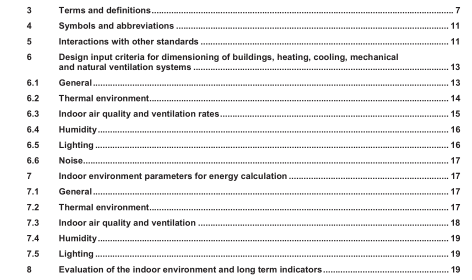EN 15251:2007 – Indoor environmental input parameters for design and assessment of energy performance of buildings addressing indoor air quality, thermal environment, lighting and acoustics

Criteria specified in national building codes for design and dimensioning of systems shall be used. The present standard gives, in informative annexes, recommended input values for use in cases where no national regulation are available. The recommended criteria are given for several categories. Design criteria for the indoor environment shall be documented by the designer. Design criteria for the indoor environment can be displayed along with the energy certificate.
6.2 Thermal environment
6.2.1 Mechanically heated and/or cooled buildings Design values for the indoor temperature for heating load and cooling load calculations shall be specified at national level. For establishing design criteria the following procedure is recommended. Criteria for the thermal environment shall be based on the thermal comfort indices PMV-PPD (predicted mean vote – predicted percentage of dissatisfied) with assumed typical levels of activity and thermal insulation for clothing (winter and summer) as described in detail in EN ISO 7730.
Based on the selected criteria (comfort category) a corresponding temperature interval is established. The values for dimensioning of cooling systems are the upper values of the comfort range and values for dimensioning of the heating system are the lower comfort values of the range. Some examples of recommended design indoor operative temperatures, derived according to this principle, for heating and cooling are presented in Table A.2.
The design values for sizing the building services are needed to fulfil the requirements in the article 4 of EPBD referring to possible negative effects of the indoor environment and to give advice about improvement of the energy efficiency of existing buildings (article 6) as well as of the heating (article 8) and cooling (article 9) of building. The design criteria in this clause are both for design of buildings (window, sun shielding, building mass, etc) and HVAC systems. Instead of using temperature as the design criterion the PMV-PPD index can be used directly.
In this way the effect of increased air velocity will be taken into account. Selection of the category is building specific, and the needs of special occupant groups such as elderly people (low metabolic rate and impaired control of body temperature) shall be considered (ISO/TS 14415). For this group of people category I is recommended. For buildings and spaces were the mechanical cooling capacity is not adequate to meet the required temperature categories the design documents shall state, using one of the methods in Annex F, how often the conditions are outside the required range.
6.2.2 Buildings without mechanical cooling For the dimensioning of the heating system the same criteria as for mechanically ventilated, cooled and heated buildings shall be used (6.2.1). The criteria for the thermal environment in buildings without mechanical cooling may be specified using the same method as in 6.2.1 or differently from those with mechanical cooling during the warm season due to the different expectations of the building occupants and their adaptation to warmer conditions. The level of adaptation and expectation is strongly related to outdoor climatic conditions.
In summer most naturally ventilated buildings are free-running so there is no mechanical cooling system to dimension and the criteria for the categories are based on indoor temperature. Summer temperatures are mainly used to design for the provision of passive thermal controls (e.g. solar shading, thermal capacity of building, design, orientation and opening of windows, etc) to avoid over heating of the building.
EN 15251:2007 – Indoor environmental input parameters for design and assessment of energy performance of buildings addressing indoor air quality, thermal environment, lighting and acoustics